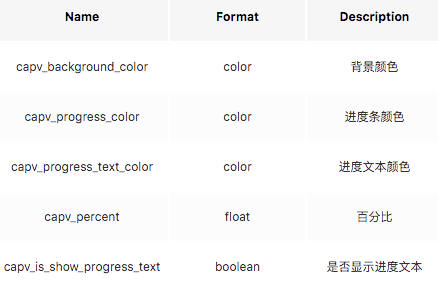
/ 今日科技快讯 /
昨日,特斯拉公布了第三季度的财报。本来外界普遍分析特斯拉会在第三季度持续亏损,但是最终公布的财报却意外地实现了1.5亿美元的净利润。另外特斯拉上海超级工厂的进度也比计划要提前,新款Model Y车型的预计上市速度也比之前要提前,首多重利好影响,特斯拉的股票盘后暴涨20%。
/ 作者简介 /
辛苦的一周又过去了,明天好好放松一下吧,祝大家周末愉快!
本篇文章来自谭嘉俊的投稿,分享了Kotlin的自定义View实战,相信会对大家有所帮助!同时也感谢作者贡献的精彩文章。
谭嘉俊的博客地址:
https://juejin.im/user/593f7b33fe88c2006a37eb9b
/ 前言 /
这是一个带弧形的进度条,其实这个控件很久之前已经实现了,但是我想用Kotlin去重写优化一遍,并且对此铺开来讲解。
项目的Github地址:
https://github.com/TanJiaJunBeyond/CircularArcProgressView
效果图

属性

使用
导入你的项目中
dependencies {
implementation 'com.tanjiajun.widget:CircularArcProgressView:1.0.2'
}
implementation 'com.tanjiajun.widget:CircularArcProgressView:1.0.2'
}
布局文件
<com.tanjiajun.widget.CircularArcProgressView
android:id="@+id/capv_first"
android:layout_width="0dp"
android:layout_height="30dp"
android:layout_marginStart="16dp"
android:layout_marginTop="16dp"
android:layout_marginEnd="16dp"
app:capv_background_color="@color/circular_arc_progress_view_first_background_color"
app:capv_is_show_progress_text="true"
app:capv_percent="0.8"
app:capv_progress_color="@color/circular_arc_progress_view_first_progress_color"
app:layout_constraintEnd_toEndOf="parent"
app:layout_constraintStart_toStartOf="parent"
app:layout_constraintTop_toTopOf="parent" />
android:id="@+id/capv_first"
android:layout_width="0dp"
android:layout_height="30dp"
android:layout_marginStart="16dp"
android:layout_marginTop="16dp"
android:layout_marginEnd="16dp"
app:capv_background_color="@color/circular_arc_progress_view_first_background_color"
app:capv_is_show_progress_text="true"
app:capv_percent="0.8"
app:capv_progress_color="@color/circular_arc_progress_view_first_progress_color"
app:layout_constraintEnd_toEndOf="parent"
app:layout_constraintStart_toStartOf="parent"
app:layout_constraintTop_toTopOf="parent" />
Kotlin
findViewById<CircularArcProgressView>(R.id.capv_first).startAnimator(duration = 2000)
Java
((CircularArcProgressView) findViewById(R.id.capv_first)).startAnimator(2000);
/ 源码分析 /
定义自定义属性,据此写出对应的获取自定义属性的代码,并且暴露一些需要用户设置的方法,代码如下:
/**
* Set percent to show the progress.
*/
var percent: Float = 0f
set(value) {
var percent = value
if (percent < 0f) {
percent = 0f
} else if (percent > 1f) {
percent = 1f
}
if (percent != field) {
field = percent
invalidate()
}
}
init {
attrs?.let { set ->
context.obtainStyledAttributes(set, R.styleable.CircularArcProgressView).apply {
bgColor =
getColor(R.styleable.CircularArcProgressView_capv_background_color, Color.BLACK)
progressColor =
getColor(R.styleable.CircularArcProgressView_capv_progress_color, Color.RED)
progressTextColor =
getColor(
R.styleable.CircularArcProgressView_capv_progress_text_color,
Color.WHITE
)
getFloat(R.styleable.CircularArcProgressView_capv_percent, 0f).let {
percent = it
}
isShowProgressText =
getBoolean(
R.styleable.CircularArcProgressView_capv_is_show_progress_text,
false
)
recycle()
}
}
}
* Set percent to show the progress.
*/
var percent: Float = 0f
set(value) {
var percent = value
if (percent < 0f) {
percent = 0f
} else if (percent > 1f) {
percent = 1f
}
if (percent != field) {
field = percent
invalidate()
}
}
init {
attrs?.let { set ->
context.obtainStyledAttributes(set, R.styleable.CircularArcProgressView).apply {
bgColor =
getColor(R.styleable.CircularArcProgressView_capv_background_color, Color.BLACK)
progressColor =
getColor(R.styleable.CircularArcProgressView_capv_progress_color, Color.RED)
progressTextColor =
getColor(
R.styleable.CircularArcProgressView_capv_progress_text_color,
Color.WHITE
)
getFloat(R.styleable.CircularArcProgressView_capv_percent, 0f).let {
percent = it
}
isShowProgressText =
getBoolean(
R.styleable.CircularArcProgressView_capv_is_show_progress_text,
false
)
recycle()
}
}
}
根据用户设置的宽高去绘制一个半径为高度一半的圆角矩形,注意要对padding属性进行处理,这部分就是背景,代码如下:
val halfHeight = height / 2f
val saveCount = canvas.saveLayer(0f, 0f, width.toFloat(), height.toFloat(), null)
// Draw background.
backgroundRectF.left = paddingStart.toFloat()
backgroundRectF.top = paddingTop.toFloat()
backgroundRectF.right = width - paddingEnd.toFloat()
backgroundRectF.bottom = height - paddingBottom.toFloat()
canvas.drawRoundRect(backgroundRectF, halfHeight, halfHeight, backgroundPaint)
val saveCount = canvas.saveLayer(0f, 0f, width.toFloat(), height.toFloat(), null)
// Draw background.
backgroundRectF.left = paddingStart.toFloat()
backgroundRectF.top = paddingTop.toFloat()
backgroundRectF.right = width - paddingEnd.toFloat()
backgroundRectF.bottom = height - paddingBottom.toFloat()
canvas.drawRoundRect(backgroundRectF, halfHeight, halfHeight, backgroundPaint)
在背景圆角矩形的左边绘制另外一个半径为高度一半的圆角矩形,宽高和背景圆角矩形一样,但是左右坐标会随着percent的增加而增加,绘制完毕后的表现就是往右移动,然后利用PorterDuffXfermode处理重叠部分,这部分就是进度,代码如下:
private val progressTextPaint by lazy {
TextPaint().apply {
isAntiAlias = true
isDither = true
style = Paint.Style.FILL
color = progressTextColor
}
}
TextPaint().apply {
isAntiAlias = true
isDither = true
style = Paint.Style.FILL
color = progressTextColor
}
}
// Draw progress.
progressRectF.left = -backgroundRectF.width() + percent * width
progressRectF.top = backgroundRectF.top
progressRectF.right = progressRectF.left + backgroundRectF.width()
progressRectF.bottom = backgroundRectF.bottom
canvas.drawRoundRect(progressRectF, halfHeight, halfHeight, progressPaint)
canvas.restoreToCount(saveCount)
progressRectF.left = -backgroundRectF.width() + percent * width
progressRectF.top = backgroundRectF.top
progressRectF.right = progressRectF.left + backgroundRectF.width()
progressRectF.bottom = backgroundRectF.bottom
canvas.drawRoundRect(progressRectF, halfHeight, halfHeight, progressPaint)
canvas.restoreToCount(saveCount)
根据用户需要绘制一个百分比文本,左右坐标也是随着percent增加而增加,绘制完毕后的表现也是向右移动,不过是位于进度条弧形的左边,注意要准确测量文字的宽高,代码如下:
if (isShowProgressText && percent >= 0.1f) {
progressTextPaint.run {
textSize = halfHeight
fontMetrics.let {
val progressText = (percent * 100).toInt().toString() + "%"
canvas.drawText(
progressText,
percent * width - progressTextPaint.measureText(progressText) - height / 5f,
halfHeight - it.descent + (it.descent - it.ascent) / 2f,
progressTextPaint
)
}
}
}
progressTextPaint.run {
textSize = halfHeight
fontMetrics.let {
val progressText = (percent * 100).toInt().toString() + "%"
canvas.drawText(
progressText,
percent * width - progressTextPaint.measureText(progressText) - height / 5f,
halfHeight - it.descent + (it.descent - it.ascent) / 2f,
progressTextPaint
)
}
}
}
暴露一个设置动画的方法。
/**
* Start animator.
*
* @param timeInterpolator the interpolator to be used by this animation. The default value is
* android.view.animation.AccelerateInterpolator.
*
* @param duration the length of the animation.
*/
@JvmOverloads
fun startAnimator(
timeInterpolator: TimeInterpolator? = AccelerateInterpolator() ,
duration: Long
) =
with(ObjectAnimator.ofFloat(this, "percent", 0f, percent)) {
interpolator = timeInterpolator
this.duration = duration
start()
}
* Start animator.
*
* @param timeInterpolator the interpolator to be used by this animation. The default value is
* android.view.animation.AccelerateInterpolator.
*
* @param duration the length of the animation.
*/
@JvmOverloads
fun startAnimator(
timeInterpolator: TimeInterpolator? = AccelerateInterpolator() ,
duration: Long
) =
with(ObjectAnimator.ofFloat(this, "percent", 0f, percent)) {
interpolator = timeInterpolator
this.duration = duration
start()
}
/ PorterDuff.Mode /
来源
为什么叫PorterDuff呢?其实是两个人名来的,一个叫Thomas Porter,另一个叫Tom Duff,他们在1984年7月发表了Compositing Digital Images,描述了12个合成运算符。
它们控制着要渲染的图像和渲染目标的内容组成的颜色,然后这个类还提供了除了那12种的其他几种混合模式,但是这些不是由这两人定义的,只是为了方便才在此类中,所以总共有18种。
源码
我们可以看下PorterDuff这个类,里面有个枚举Mode,代码如下:
public enum Mode {
CLEAR (0),
SRC (1),
DST (2),
SRC_OVER (3),
DST_OVER (4),
SRC_IN (5),
DST_IN (6),
SRC_OUT (7),
DST_OUT (8),
SRC_ATOP (9),
DST_ATOP (10),
XOR (11),
DARKEN (16),
LIGHTEN (17),
MULTIPLY (13),
SCREEN (14),
ADD (12),
OVERLAY (15);
Mode(int nativeInt) {
this.nativeInt = nativeInt;
}
/**
* @hide
*/
public final int nativeInt;
}
CLEAR (0),
SRC (1),
DST (2),
SRC_OVER (3),
DST_OVER (4),
SRC_IN (5),
DST_IN (6),
SRC_OUT (7),
DST_OUT (8),
SRC_ATOP (9),
DST_ATOP (10),
XOR (11),
DARKEN (16),
LIGHTEN (17),
MULTIPLY (13),
SCREEN (14),
ADD (12),
OVERLAY (15);
Mode(int nativeInt) {
this.nativeInt = nativeInt;
}
/**
* @hide
*/
public final int nativeInt;
}
PorterDuff总共有18种模式,以下展示了这些模式对应的名字、图片和描述,可以点开图片查看,图片如下:

/ 延迟属性Lazy /
这个控件的代码也用上了延迟属性Lazy,代码如下:
private val progressTextPaint by lazy {
TextPaint().apply {
isAntiAlias = true
isDither = true
style = Paint.Style.FILL
color = progressTextColor
}
}
TextPaint().apply {
isAntiAlias = true
isDither = true
style = Paint.Style.FILL
color = progressTextColor
}
}
我们可以看到,lazy函数是接受一个Lambda表达式,如果函数最后一个参数是Lambda表达式的话,可以提到小括号外边,并且小括号也可以省略;
调用延迟属性有这样的特征,第一次拿到属性的值(调用get方法)会执行已传递给函数的Lambda表达式并且记录结果,后续调用get()只是返回记录的结果。
我们可以看下源码,提供了三个函数。
lazy(initializer: () -> T)
public actual fun <T> lazy(initializer: () -> T): Lazy<T> = SynchronizedLazyImpl(initializer)
这个函数接受一个Lambda表达式,并且返回Lazy,并且调用SynchronizedLazyImpl函数,而且我们可以得知多个线程去调用这个lazy函数是安全的,代码如下:
private class SynchronizedLazyImpl<out T>(initializer: () -> T, lock: Any? = null) : Lazy<T>, Serializable {
private var initializer: (() -> T)? = initializer
private var _value: Any? = UNINITIALIZED_VALUE
// final field is required to enable safe publication of constructed instance
private val lock = lock ?: this
override val value: T
get() {
val _v1 = _value
if (_v1 !== UNINITIALIZED_VALUE) {
return _v1 as T
}
return synchronized(lock) {
val _v2 = _value
if (_v2 !== UNINITIALIZED_VALUE) {
(_v2 as T)
} else {
val typedValue = initializer!!()
_value = typedValue
initializer = null
typedValue
}
}
}
override fun isInitialized(): Boolean = _value !== UNINITIALIZED_VALUE
override fun toString(): String = if (isInitialized()) value.toString() else "Lazy value not initialized yet."
private fun writeReplace(): Any = InitializedLazyImpl(value)
}
private var initializer: (() -> T)? = initializer
private var _value: Any? = UNINITIALIZED_VALUE
// final field is required to enable safe publication of constructed instance
private val lock = lock ?: this
override val value: T
get() {
val _v1 = _value
if (_v1 !== UNINITIALIZED_VALUE) {
return _v1 as T
}
return synchronized(lock) {
val _v2 = _value
if (_v2 !== UNINITIALIZED_VALUE) {
(_v2 as T)
} else {
val typedValue = initializer!!()
_value = typedValue
initializer = null
typedValue
}
}
}
override fun isInitialized(): Boolean = _value !== UNINITIALIZED_VALUE
override fun toString(): String = if (isInitialized()) value.toString() else "Lazy value not initialized yet."
private fun writeReplace(): Any = InitializedLazyImpl(value)
}
我们可以看到用的是**双重检查锁(Double Checked Locking)**来保证线程安全。
lazy(mode: LazyThreadSafetyMode, initializer: () -> T)
public actual fun <T> lazy(mode: LazyThreadSafetyMode, initializer: () -> T): Lazy<T> =
when (mode) {
LazyThreadSafetyMode.SYNCHRONIZED -> SynchronizedLazyImpl(initializer)
LazyThreadSafetyMode.PUBLICATION -> SafePublicationLazyImpl(initializer)
LazyThreadSafetyMode.NONE -> UnsafeLazyImpl(initializer)
}
when (mode) {
LazyThreadSafetyMode.SYNCHRONIZED -> SynchronizedLazyImpl(initializer)
LazyThreadSafetyMode.PUBLICATION -> SafePublicationLazyImpl(initializer)
LazyThreadSafetyMode.NONE -> UnsafeLazyImpl(initializer)
}
这个函数接受两个参数,一个是LazyThreadSafetyMode,另外一个是Lambda表达式,并且返回Lazy,LazyThreadSafetyMode是个枚举类,代码如下:
public enum class LazyThreadSafetyMode {
SYNCHRONIZED,
PUBLICATION,
NONE,
}
SYNCHRONIZED,
PUBLICATION,
NONE,
}
使用SYNCHRONIZED可以保证只有一个线程初始化实例,实现细节在上面也说过了;使用PUBLICATION允许多个线程并发初始化值,但是只有第一个返回值用作实例的值;使用NONE不会有任何线程安全的保证以及的相关的开销,所以你如果你确认初始化总是发生在同一个线程的话可以用此模式,减少一些性能上的开销。
lazy(lock: Any?, initializer: () -> T)
public actual fun <T> lazy(lock: Any?, initializer: () -> T): Lazy<T> = SynchronizedLazyImpl(initializer, lock)
这个函数接受两个参数,一个是你使用指定的对象(lock)进行同步,另外一个是Lambda表达式,返回的是Lazy,调用的是SynchronizedLazyImpl函数,上面也说过了,这里不再赘述。
/ @JvmOverloads /
如果写一个有默认参数值的Kotlin函数,在Java中只会有个一个所有参数都存在的方法可以调用,如果希望向Java调用者暴露多个重载,可以使用**@JvmOverloads**注解。
拿这个控件的代码举例,代码如下:
class CircularArcProgressView constructor(
context: Context,
attrs: AttributeSet? = null,
defStyleAttr: Int = 0
) : View(context, attrs, defStyleAttr) {
// 省略实现代码
}
context: Context,
attrs: AttributeSet? = null,
defStyleAttr: Int = 0
) : View(context, attrs, defStyleAttr) {
// 省略实现代码
}
反编译成Java代码,代码如下:
public final class CircularArcProgressView extends View {
public CircularArcProgressView( Context context, AttributeSet attrs, int defStyleAttr) {
// 省略实现代码
}
public CircularArcProgressView( Context context, AttributeSet attrs) {
// 省略实现代码
}
public CircularArcProgressView( Context context) {
// 省略实现代码
}
}
public CircularArcProgressView( Context context, AttributeSet attrs, int defStyleAttr) {
// 省略实现代码
}
public CircularArcProgressView( Context context, AttributeSet attrs) {
// 省略实现代码
}
public CircularArcProgressView( Context context) {
// 省略实现代码
}
}
推荐阅读:
欢迎关注我的公众号
学习技术或投稿
![]()

长按上图,识别图中二维码即可关注





















 2724
2724











 被折叠的 条评论
为什么被折叠?
被折叠的 条评论
为什么被折叠?








